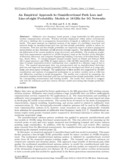| dc.contributor.author | Oyie, Nicholas O. | |
| dc.contributor.author | Afullo, T. J. O. | |
| dc.date.accessioned | 2021-04-20T08:49:18Z | |
| dc.date.available | 2021-04-20T08:49:18Z | |
| dc.date.issued | 2018-08 | |
| dc.identifier.citation | 2018 Progress In Electromagnetics Research Symposium (PIERS — Toyama), Japan, 1–4 August | en_US |
| dc.identifier.uri | https://ieeexplore.ieee.org/stamp/stamp.jsp?arnumber=8598036 | |
| dc.identifier.uri | https://www.semanticscholar.org/paper/An-Empirical-Approach-to-Omnidirectional-Path-Loss-Oyie-Afullo/1643be750f763ff7f3a6b8b2eb9e3adbe21aff50 | |
| dc.identifier.uri | http://hdl.handle.net/123456789/4591 | |
| dc.description.abstract | Millimeter wave frequency bands present a huge bandwidth for fifth generation wireless communication networks. Wireless networks deployment within indoor environments will pose a challenge due to propagation characteristics of signals at millimeter wave frequency bands. This paper presents an empirical analysis of the impact of a building’s structural and material design on omnidirectional path loss and line-of-sight probability models in indoor environments. Path loss and line-of-sight probability are important aspects of indoor propagation characteristics as they determine overall network coverage capacity. The studied models address the deficiencies of the current models in terms of accuracy and reliability. The models are synthesized from measurements conducted at 18 GHz frequency band on the 5th floor of the Discipline of Electrical, Electronic and Computer Engineering building, University of KwaZulu-Natal, Durban, South Africa. A costume-designed channel sounder based on Rohde and Schwarz SMF 100A signal generator and FSIQ 40 signal analyzer with 120MHz bandwidth was used. More than 13 unique transmitter-receiver combinations were considered in a distance range of 2m to 24 m. The acquired measurement data was post-processed and an omnidirectional dual slope path loss and improved line-of-sight probability model was developed and fitted on it using minimum root mean square technique. The applications of these models were supported by detailed consideration and analysis of propagation mechanisms in an indoor corridor such as reflection and diffraction, resulting in modal propagation. The models were evaluated by comparing the simulated omnidirectional dual-slope path loss and improved line-of-sight probability model with the corresponding measurements and existing models. The results were observed to compare well with the well-known path loss close-in reference model and existing line-of-sight probability models. | en_US |
| dc.language.iso | en | en_US |
| dc.title | An Empirical Approach to Omnidirectional Path Loss and Line-of-sight Probability Models at 18GHz for 5G Networks | en_US |
| dc.type | Article | en_US |

